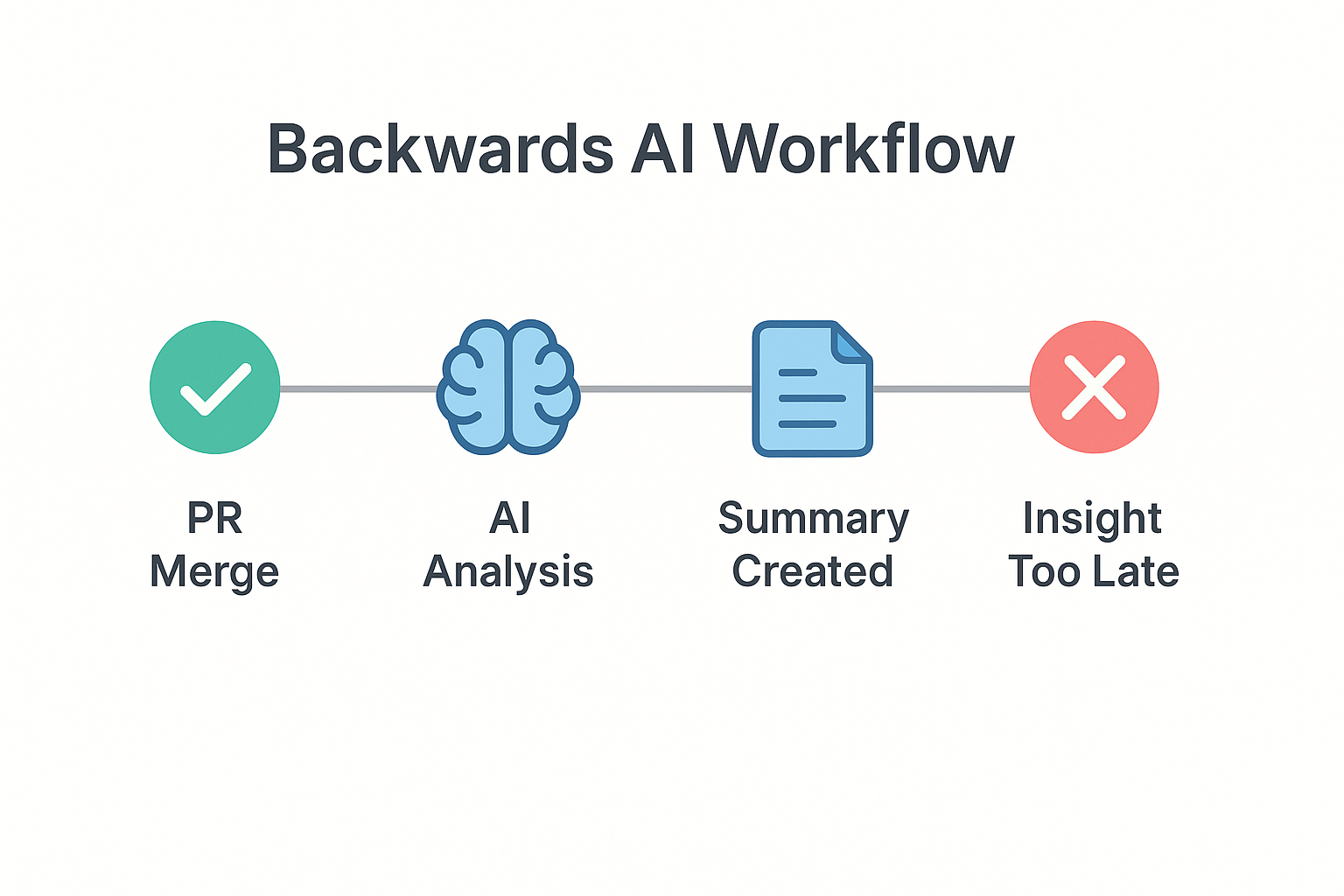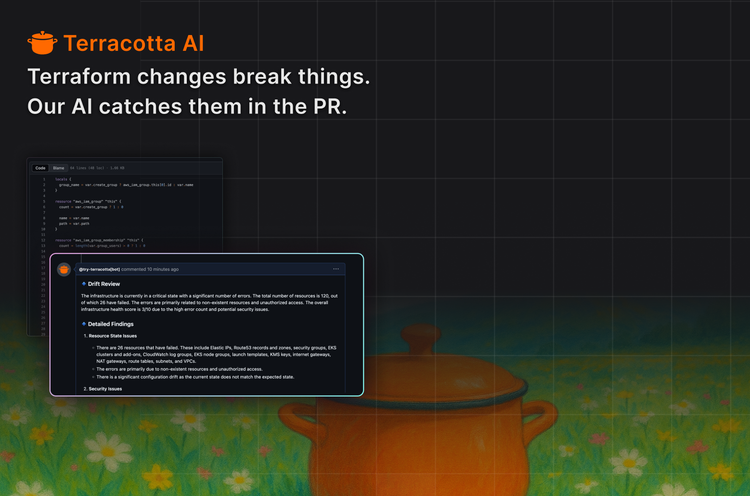Why Your AI-Powered Infrastructure as Code Workflow is Backwards

Recently, I had a conversation that stopped me in my tracks.
I was speaking with an infrastructure team about their Terraform workflows. They were excited to show me something they'd built: an AI system that analyzes their infrastructure changes and explains them in plain English.
"Check this out," one engineer said, pulling up a recent deployment. "Our AI takes the Terraform plan output and tells stakeholders exactly what we're building. No more trying to explain technical details in meetings."
I watched as their AI generated a clear summary: "This change provisions a new data processing service with dedicated storage, increases compute capacity by 35%, and updates network access rules for the analytics environment."
It was impressive. Their decision-makers could finally understand infrastructure changes without having to decode technical jargon.
Then I asked the question that changed everything: "When does this analysis happen?"
"Right after we merge the PR," they said matter-of-factly. "It's part of our automated workflow."
I paused.
"So by the time the AI explains what the change does, you've already decided to deploy it?"
"Exactly."
That's when it hit me. They'd built brilliant AI analysis and put it in precisely the wrong place.
The Backwards Pattern

This enterprise isn't alone. I've seen this pattern everywhere.
Teams build AI that can perfectly explain infrastructure changes, then use it for post-mortem documentation instead of decision support.
Picture their actual workflow:
- Monday: A developer opens a PR to update their data pipeline service. The Terraform plan shows changes to storage permissions, compute instances, and network configurations.
- Tuesday: A senior team member reviews the PR. They scan the plan, see familiar patterns, and think, "This looks standard." They approve it.
- Wednesday: The change is merged and deployed. The AI analyzes the plan and generates a comprehensive summary explaining that this change affects data processing capacity, modifies access permissions, and could impact processing times.
- Thursday: The summary reaches the team lead, who reads it and thinks, "I wish I'd known this affected processing performance before we deployed it."
The AI insight arrived 3 days too late.
The Conversation That Revealed Everything
I continued to work with the infrastructure team. "Why does the AI analysis happen after the merge instead of during the review?"
"Well," one of them said, "our workflow is already established. We have our deployment pipeline set up, and the AI fits naturally into the post-deployment phase."
"But wouldn't it be more useful during the PR review?"
"Probably, but we'd have to restructure our entire process."
There it was. They'd built AI around their existing human-centric workflow instead of redesigning the workflow for AI.
The Real Problem
Here's what I realized:
Current Infrastructure as Code workflows were designed around a fundamental assumption that humans would be the primary interpreters of infrastructure changes.
Think about how Terraform workflows evolved:
- Human writes code
- Human reviews code
- Human interprets plans
- Human approves change
- Human deploys infrastructure
Every tool, every process, every workflow was built around humans doing the interpretation work. Then AI came along, and instead of questioning this assumption, teams asked: "How can we add AI to our existing workflow?"
The answer was always: "AI can explain what humans decided" or "AI can validate what humans approved."
But nobody asked: "What if AI did the interpretation work and humans made the decisions?"
The Interpretation Bottleneck
I observed this team conducting their weekly infrastructure reviews. Multiple engineers are spending hours parsing Terraform plans, trying to understand the impact scope, calculating resource implications, and predicting deployment risks.
These weren't inexperienced engineers. They were skilled professionals doing work that AI could do better.
"How do you handle complex multi-service changes?" I asked.
"Honestly, we mostly cross our fingers," one admitted. "The plans are so complex that you can't really predict all the interactions."
That's when I realized the actual cost of backward AI workflows.
They had AI that could analyze infrastructure context, understand service dependencies, and predict the impacts of deployments. However, they were using it for documentation rather than decision-making.
Meanwhile, their engineers were burning mental energy on interpretation work that AI could handle instantly.
The Scale Problem
This team processes a substantial volume of infrastructure changes every week. "It's manageable," they told me. "We can review everything manually.", but manageable isn't optimal.
I did some quick math:
- Multiple engineers × several hours per week = substantial interpretation work
- Hours × 52 weeks = hundreds of hours per year
- Hundreds of hours of senior engineering time spent parsing Terraform plans
What could those engineers build with all that freed-up time?
"We could probably deliver several major platform improvements," one said thoughtfully.
That's the hidden cost of backwards AI workflows.
The Aha Moment
"What if," I asked, "the AI analysis happened before the human review?"
They looked at me with curiosity.
"Think about it," I continued. "Instead of spending time figuring out what a change does, what if the AI had already analyzed it and told you: 'This change affects data processing for key workflows, increases storage utilization by 20%, and requires a brief service restart'?"
"Then you could focus on whether that's the right business decision, not on figuring out what the technical change means."
I could see the realization dawning.
The Right Workflow
We sketched out what their workflow could look like:
Instead of:
- The developer writes Terraform code
- The reviewer examines the code and interprets the plan
- The reviewer approves based on their interpretation
- AI explains what was approved (too late)
It should be:
- The developer writes Terraform code
- AI analyzes code, state, and infrastructure context
- AI explains impact, risks, and business implications
- The reviewer examines the AI analysis and makes an informed decision
AI does the interpretation. Humans make the decisions.
The Timing Revolution
The critical insight isn't just about using AI, it's about timing.
Current timing:
- Decision point: PR review (human interpretation)
- AI analysis: Post-merge (documentation)
Correct timing:
- AI analysis: Pre-review (context gathering)
- Decision point: PR approval (informed human decision)
AI should analyze first. Humans should approve second.
The Competitive Advantage
I left that conversation thinking about competitive advantage.
This team is spending hundreds of hours per year on interpretation work that AI could do instantly. Their engineers are acting as human Terraform parsers instead of building new systems.
Meanwhile, teams that adopt this model are deploying infrastructure with confidence, while others continue to refine their plans.
The question isn't whether AI will transform Infrastructure as Code workflows. It's whether you'll adopt AI-native workflows before your competitors do.
The Path Forward
If you're building AI into your Infrastructure as Code workflow, ask yourself:
Are you solving the right problem at the right time?
- Does your AI analysis happen before or after the decision?
- Are your humans interpreting infrastructure changes or approving them?
- Is AI providing context for decisions or explaining decisions after they're made?
The teams that get this right will be deploying infrastructure with confidence, while others are still parsing Terraform plan. Currently, IaC tools assume humans will interpret everything. It's time to turn that assumption on its head.
AI should analyze first. Humans should approve second.
Stop Building Backwards AI Workflows for Infrastructure as Code
At Terracotta AI, we built our platform around this principle. Instead of post-merge explanations, we provide pre-merge intelligence.
Terraform changes break things. Our AI catches them in the PR.
We analyze your Terraform changes right inside the pull request, before they hit your pipeline. Our AI understands your code, state, and live infrastructure context to automatically detect drift, missing dependencies, cost spikes, exposed secrets, and blast radius issues.
No workflow changes required. We work with your existing GitHub or GitLab process, providing the contextual intelligence that turns complex infrastructure plans into clear, actionable insights.
Ready to flip your workflow from backwards to intelligent?
👉 Learn more about Terracotta AI here: https://tryterracotta.com





Comments ()